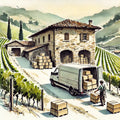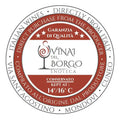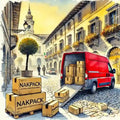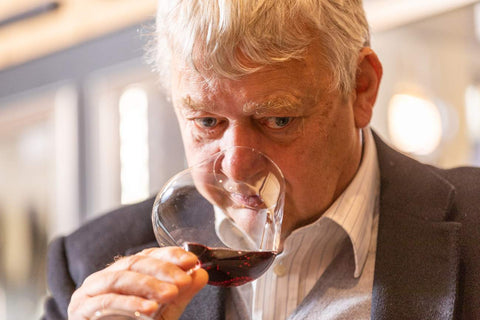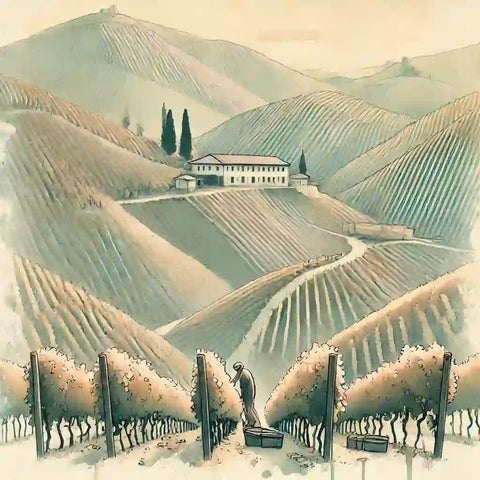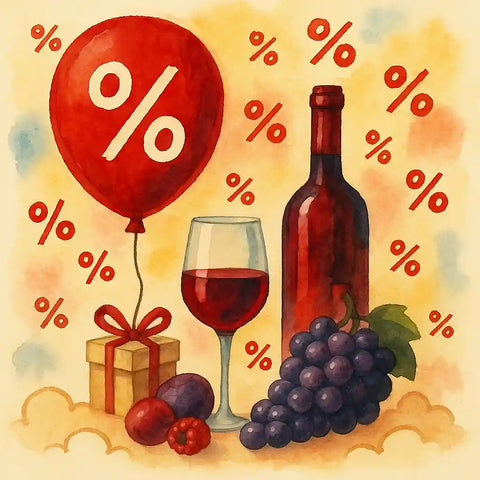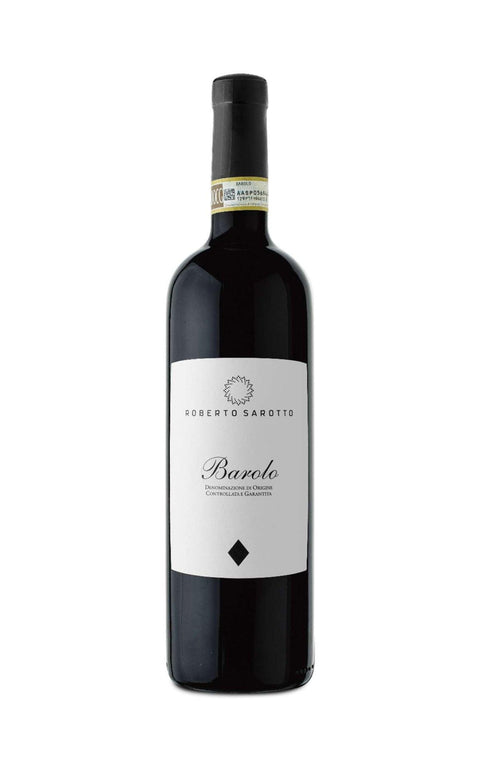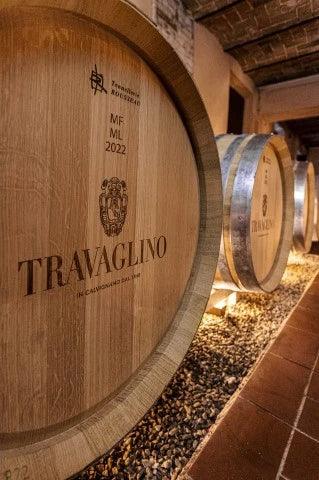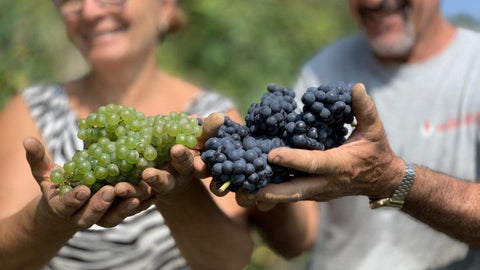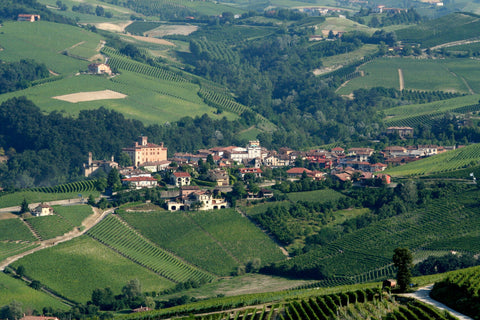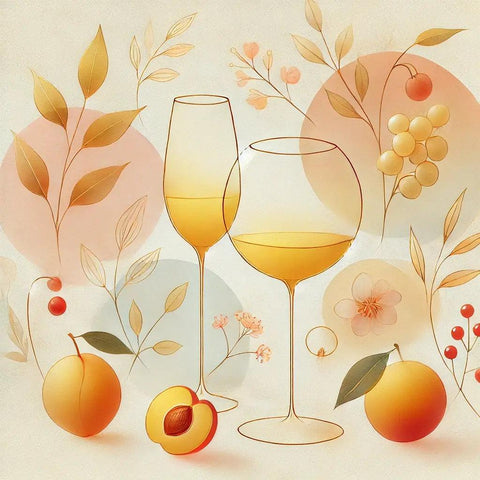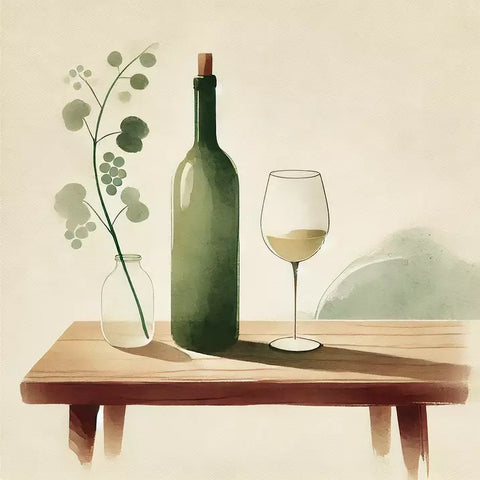Glossary of Rosés and Grape Varieties Used
What is a Rosé Wine?
It is a wine obtained from red grapes but vinified as a white, with minimal contact between skins and must. The result is a more or less intense rosé color and a fresh and fruity aromatic profile.
How is a Rosé Produced?
The main methods are direct pressing, short maceration and bleeding. Each technique influences the color, aromas and structure of the wine.
Direct Pressing
Method in which the red grapes are pressed immediately after harvest. The must has little contact with the skins, obtaining a very light and delicate rosé.
Short Maceration
The must remains in contact with the skins for a few hours before fermentation. The color is more intense and the aromas more complex.
Bloodletting Method (Saignée)
Part of the must is taken from a tank intended for red winemaking. The resulting rosé wine has more body and aromatic intensity.
Color of Rosé
It can vary from blush pink to cherry red. It depends on the grape variety, the duration of the maceration and the production technique.
Rosé or Rosato?
In Italy, "rosato" is used, while "rosé" is the French term, often associated with the wines of Provence. Both indicate the same style.
Types of Rosé
Rosés can be still, sparkling or spumante. The typology influences pairings, sensory profile and consumption occasions.
Classic Method Rosé
Sparkling wine produced with refermentation in the bottle according to the Classic Method. It has fine bubbles, structure and notes of bread crust and red fruits.
Longevity of Rosés
Most are consumed within 1–2 years. Some structured rosés or sparkling wines can evolve positively for 3–5 years.
Rosé Wine Service
Serve at 8–12°C in tulip or universal glasses. It is important not to serve it too cold to avoid losing the delicate aromas.
Pairings with Rosé
Ideal with appetizers, delicate cured meats, fish, ethnic cuisine, white meats, grilled vegetables and summer dishes. Also excellent on its own as an aperitif.
Rosé winemaking
Specific process that involves careful control of the contact time between the skins and the must to obtain the right balance of color and aroma.
Sangiovese rosé
Generic indication for a rosé obtained from Sangiovese, appreciated for the balance between acidity, red fruit and good drinkability.
Dry rosé
Rosé wine with no perceptible residual sugar, fresh, light and perfect to accompany light meals and Mediterranean dishes.
Sweet rosé
Rosé with a slight perception of sweetness due to a residual sugar content, often chosen for aperitifs or spicy dishes.
Sparkling rosé
Rosé with natural or added carbon dioxide, which gives liveliness and freshness. Excellent with appetizers or fried foods.
Sparkling rosé
Rosé wine with persistent foam, produced with Charmat method or Classic Method. Elegant, aromatic, ideal for toasts.
Still rosé
The most common type: wine without bubbles, obtained by direct pressing or short maceration. Versatile and gastronomic.
Scent of rosé
Typically floral and fruity: hints of rose, raspberry, pomegranate, citrus and, in some cases, light spices can be recognized.
Body of the rosé
Varies according to the grape variety and production method. Light rosés are fresh and drinkable, structured ones are more complex and also suitable for complete meals.
Acidity of rosé
A key element for the freshness and pleasantness of the sip. The well-balanced acidity makes the rosé ideal for summer and food.
Bitter finish
Typical characteristic of some rosés, due to phenolic compounds present in the wine. It gives character and definition to the sip.
Summer rosé
Simple, fresh and fragrant rosé wine, designed to be consumed young and very cold, ideal for the summer season.
Gastronomic rosé
A more complex and structured rosé, suitable to accompany elaborate dishes and main courses, not just appetizers or aperitifs.
Residual sugar
The amount of unfermented sugar remaining in the wine. In dry rosés it is minimal, but can vary in medium-dry or sweet rosés.
Bloodletting rosé
Obtained by taking a part of the must from a red vinification. It often has more body and greater intensity of flavor.
Pressed rosé
Synonym for direct pressing rosé, lighter in colour and more delicate in profile than blood-pressed rosé.
Natural rosé
Wine produced with minimal intervention, sometimes without filtration, with spontaneous fermentations and low sulphites.
Biodynamic rosé
Wine produced following the principles of biodynamics, with attention to the lunar cycle and respect for the environment.
Organic Rosé
Rosé wine obtained from grapes grown according to certified organic practices, without the use of chemical pesticides or synthetic fertilizers.
Provence Style
Style of rosé inspired by the wines of Provence: pale color, delicate profile, dry, floral and citrus. Increasingly popular also in Italy.
Color extraction
Controlled process during winemaking that determines the intensity of the rosé's colour, depending on the contact time between the must and the skins.
Skin-must contact
Key phase for the production of rosés, in which the must remains in contact with the grape skins for a short time (from a few minutes to a few hours).
Draining
Separation of the must from the skins during winemaking, essential for controlling the color and structure of the rosé.
Destemming and crushing
Initial operation involving the pressing and destemming of the grapes, often followed by rapid pressing in the production of rosés.
Static decantation
Method for clarifying must after pressing. The must is left to rest to naturally separate the solids before fermentation.
Fermentation temperature
Generally controlled between 14°C and 18°C in rosés to preserve floral and fruity aromas. Lower than that of reds.
Clarity
An important visual parameter for rosés, which must appear bright and clean, often thanks to light filtration and natural clarification.
Color stability
The ability of rosé to maintain its original color over time, often improved with the targeted use of sulphites or delicate filtration.
Reduction of oxidative contact
Winemaking strategy to prevent oxygen from compromising the color and fresh aromas of rosé. It involves processing in a controlled environment.
Refining in steel
A common technical choice for rosés, it allows to preserve freshness, fragrance and aromatic purity. Alternative to wood.
Refining on the yeasts
Period in which the wine remains in contact with the yeasts after fermentation, giving roundness and complexity, also used for some structured rosés.
Structured rosé
Rosé with greater body and intensity, often from longer maceration or bleeding. May also be suitable for aging.
Provencal style
Very light, dry, elegant and delicate rosé, with citrus and floral notes. Model followed by many Italian producers.
Rosé from terroir
Expression indicating a rosé strongly influenced by the characteristics of the territory (soil, microclimate, altitude).
Soft pressing
A delicate technique that avoids the extraction of tannins and colors that are too intense. Essential for elegant and fine rosés.
Targeted sulphitation
Controlled addition of sulfur dioxide to protect the wine from oxidation and bacteria. In rosés it is used in a very calibrated way.
Reduction vinification
Technique in which wine is protected from oxygen during vinification to preserve fresh, primary aromas. Common in high-quality rosés.
Tangential filtration
Modern method of wine clarification and stabilization that guarantees clarity and microbiological stability, also used in premium rosés.
Primary aromas
Fragrances derived directly from the grape, such as flowers, citrus, strawberries, raspberries. In rosés they are predominant compared to secondary and tertiary ones.
Taste tension
Sensation of dynamism and freshness on the palate, given by acidity, minerality and aromatic precision. Distinctive character of the best rosés.
Aleatico
Aromatic grape variety used for scented rosés, often sweet or semi-dry, with hints of rose and candied red fruit.
Aglianico Rosé
A rosé version of the powerful Southern Italian grape variety; it maintains structure and spicy notes with a more marked freshness.
Black Bombino
Typical grape variety of Puglia, ideal for the production of light, fruity rosés that are pleasant to drink when young.
Barbera Rosé
Rosé obtained from Barbera, with lively acidity, crisp red fruit and a good mineral boost.
Goodard
Emilian or Piedmontese variety which, when vinified as a rosé, produces fragrant, fruity and ready-to-drink wines.
Cherry
Abruzzese rosé obtained from Montepulciano, characterised by a deep colour and an almost light red body.
Cesanese Rosé
A Lazio rosé with personality, with spicy and floral notes on a base of softness and freshness.
Claret
Garda rosé, produced with Groppello, Marzemino, Barbera and Sangiovese; light and floral.
Cherry tree
A grape variety that produces juicy and fragrant rosés, with evident hints of cherry and strawberry.
Corvina Rosé
Veronese grape used in Bardolino Chiaretto, produces fresh rosés with notes of citrus and flowers.
Sweet Rosé
Rosé version of a Piedmontese classic, more drinkable and delicate, with notes of fruit and almond.
Freisa Rosé
Lively and fragrant Piedmontese rosé, sometimes with a light fizziness and spicy hints.
Frappato
Sicilian grape variety that produces light and fragrant rosés, with notes of pomegranate, raspberry and sweet spices.
Pink Gaglioppo
Typically Calabrese, the pink version is fresher and more floral, maintaining a spicy and structured hint.
Groppello
A fundamental grape in Chiaretto del Garda, it gives elegance, acidity and floral aromas to rosés.
Tear
An aromatic grape variety from the Marche region, it produces intense and floral rosés, with hints of rose and violet.
Lagrein Kretzer
Traditional South Tyrolean rosé, with an intense colour and important structure, with spicy and fruity notes.
Lambrusco Rosé
Rosé and often sparkling version, with a lively and refreshing taste, excellent as an aperitif.
Black Malvasia
Used in Salento, it produces aromatic, soft rosés rich in the scents of ripe fruit and flowers.
Montepulciano Rosé
Robust grape that in rosé gives intense wines, with medium body and hints of red fruit and spices.
Negroamaro Rosé
One of the symbolic rosés of Salento, with notes of cherry, pomegranate and a pleasantly bitter finish.
Nerello Mascalese Rosé
Volcanic rosé from Etna, mineral, citrusy, fresh and often with smoky notes.
Nero d'Avola Rosé
Sicilian rosés full of sun, with good structure and aromas of red fruits and citrus.
Pelaverga Rosé
A rare Piedmontese grape variety that, in rosé, expresses very elegant peppery, floral and citrus notes.
Perricone
Sicilian grape variety for medium-bodied rosés, with spicy tones and black fruits in the background.
Pinot Noir Rosé
Delicate and refined, with aromas of rose petals, raspberry and a subtle minerality.
Raboso Rosé
Venetian rosés with a strong acidity, hints of blackcurrant, black cherry and a good finish.
Refosco Rosé
Friulian grape variety that produces savoury, structured rosés with light herbaceous and plum notes.
Rossese Rosé
Ligurian grape variety that in rosé maintains floral notes, freshness and a delicately saline finish.
Sangiovese Rosé
Tuscan and Umbrian rosés with a pale color, elegant aromas and a light, harmonious body.
Susumaniello
A rediscovered grape variety from Salento, it offers intense, fruity and brightly colored rosés.
Teroldego Rosé
Trentino grapes that in rosé produce wines with a lively color and a flavor of fresh berries.
Troy (Troy Grapes)
Apulian rosés with good body and spicy profile, with a delicate tannic texture.
Vernatsch (Slave)
Alto Adige grapes for delicate, floral rosés, with good acidity and mountain freshness.
Zibibbo Rosé
Aromatic variety for intensely scented, floral and slightly sweet rosés.
Classic Method Rosé
Sparkling rosé wine produced with refermentation in the bottle, aromatic finesse and elegant perlage.
Direct Pressing
Rosé winemaking method where the red grapes are immediately pressed, limiting the extraction of color.
Short Maceration
The skins remain in contact with the must for a few hours, giving the rosé its light color and delicate aromas.
Grey Wine
A very clear rosé style, typical of France, obtained by almost immediate pressing of red grapes.
Provence
French region symbol of rosé, with light, elegant and fragrant wines, often imitated around the world.
Coppery
Wine obtained from white grapes vinified with the skins, such as Pinot Grigio in orange-rosé style.
Bloodletting
Method in which part of the must is removed from a red winemaking process to obtain a more intense rosé.
Brut Rose
Dry rosé sparkling wine, often obtained from Pinot Noir grapes or blends, ideal for refined aperitifs.
Abruzzo Cerasuolo DOC
Name dedicated to the rosé from Montepulciano, with a deep color and strong flavor.
Chiaretto of Bardolino DOC
Lake Garda denomination for rosés from Groppello and consortium grapes, fresh and floral.
Tuscan Rosé
Geographical indication for Tuscan rosés, usually made from Sangiovese, with a fruity and gastronomic character.
Salento Rosé PGI
Apulian indication that includes some of the most intense and structured rosés in Italy.
Etna Rosé DOC
Elegant and mineral volcanic rosé, from Nerello grapes grown on the slopes of Etna.






